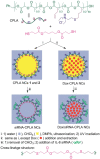Biodegradable Polymers for Gene-Delivery Applications
- PMID: 32280211
- PMCID: PMC7125329
- DOI: 10.2147/IJN.S222419
Biodegradable Polymers for Gene-Delivery Applications
Abstract
Gene-based therapies have emerged as a new modality for combating a myriad of currently incurable diseases. However, the fragile nature of gene therapeutics has significantly hampered their biomedical applications. Correspondingly, the development of gene-delivery vectors is of critical importance for gene-based therapies. To date, a variety of gene-delivery vectors have been created and utilized for gene delivery. In general, they can be categorized into viral- and non-viral vectors. Due to safety issues associated with viral vectors, non-viral vectors have recently attracted much more research focus. Of these non-viral vectors, polymeric vectors, which have been preferred due to their low immunogenicity, ease of production, controlled chemical composition and high chemical versatility, have constituted an ideal alternative to viral vectors. In particular, biodegradable polymers, which possess advantageous biocompatibility and biosafety, have been considered to have great potential in clinical applications. In this context, the aim of this review is to introduce the recent development and progress of biodegradable polymers for gene delivery applications, especially for their chemical structure design, gene delivery capacity and additional biological functions. Accordingly, we first define and categorize biodegradable polymers, followed by describing their corresponding degradation mechanisms. Various types of biodegradable polymers resulting from natural and synthetic polymers will be introduced and their applications in gene delivery will be examined. Finally, a future perspective regarding the development of biodegradable polymer vectors will be given.
Keywords: biodegradable polymers; gene delivery; gene therapy; non-viral vectors; polymeric vectors.
© 2020 Chen et al.
Conflict of interest statement
The authors report no conflicts of interest in this work.
Figures










References
Publication types
MeSH terms
Substances
LinkOut - more resources
Full Text Sources
Other Literature Sources

